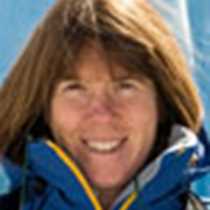LeConte Bay and Petersburg
Calm seas in the morning reflected multilayered sky, rain and sun competing for space, and rainbows the happy result. We set out in the zodiacs, cruising amongst icebergs from the LeConte Glacier, marveling at their multifaceted surfaces sparkling blue, clear and white. Our destination: a landing in the intertidal zone. Our goal: exploration!
Successfully negotiating our first “wet landing,” we set out to explore the margin of land and sea. Our timing was great: just before low tide, leaving many zones of marine algae and intertidal creatures exposed to our observations. It is an intricate and detailed community that lives in this place, exposed twice a day and covered with salty sea the rest of the time.
Some finds were unique to the place we visited, such as the huge icebergs resting on the ground and the strange tracks they gouged in the mud that marked their passage while floating. We discovered the stumps of “interglacial” trees here too; the base of great trees mowed down by the glacier during LeConte’s last advance, uncovered when the glacier began its current retreat about 250 years ago. The small and the large, the short-lived and timeless, gave us a sense of place in the fabric in time.
After lunch we sailed to Petersburg. We saw signs of this community’s Norwegian heritage, in rosemaled window frames, a model Viking ship, and the Sons of Norway Hall. That it’s a fishing town was obvious too: the harbor full of fishing boats, processors on tall pilings along the shoreline, inlaid halibut art in the sidewalks and streets named after famous old boats of Petersburg’s fleet. There was time for walking, or shopping, or biking around town.
Time, too, for naturalist-led walks on Kupreanof Island across the channel from town, where a peat bog provided a new type of habitat to explore. Ground that you can pick up and wring water out of, peat supports a dazzling array of interesting plants. There are carnivorous plants, plants that make delicious berries, medicinal plants. Trees here grow mere inches a year. It was a place to use the senses, smelling the bog orchids and the Labrador tea, tasting a blueberry or two, breathing clean air and listening to quiet. Who knew a bog could be so refreshing?
At last we left Petersburg, replenishing ourselves with a feast of Dungeness crab, bound for Frederick Sound and beyond, to our next destination.




